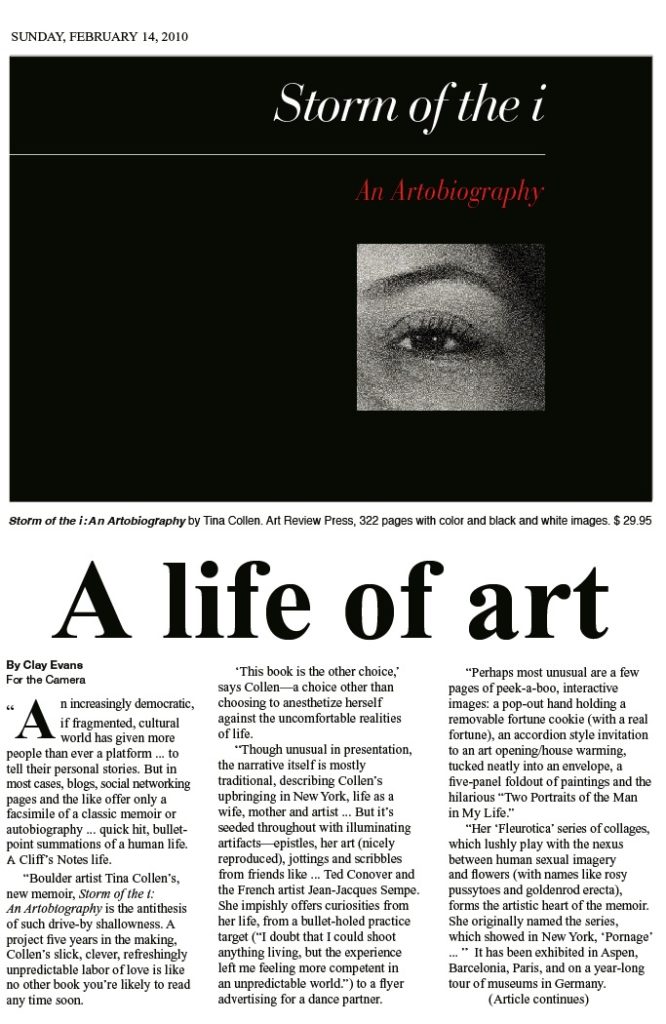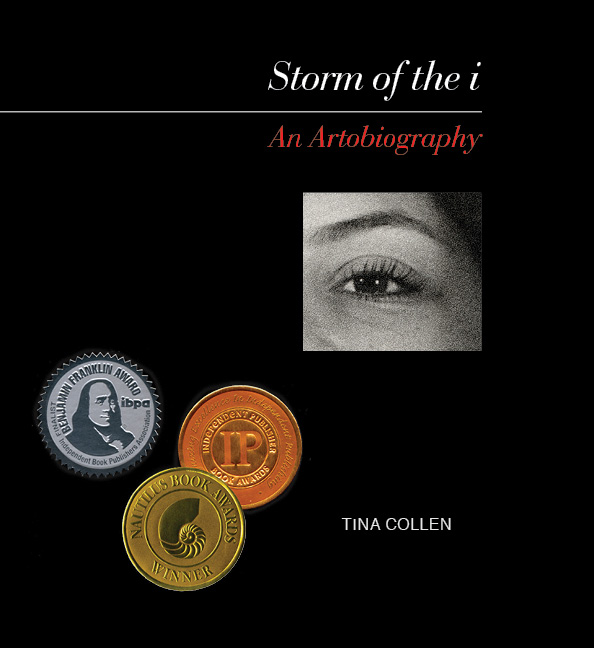At the time I finished writing this book, he hadn’t spoken to me for fifteen years. My mother even asked me not to call the house, because he’d told her that if I did he would rip the phone right out of the wall. So I stopped calling. Though I was never physically abused, my father’s anger was the crucible in which I was forged.
Here’s a passage about dinner time at my house when I was a kid. At the top of the page it says:
Navigating childhood is a daunting feat for anyone, particularly a child.
“When my sixth-grade science class was introduced to Darwin’s Theory of Evolution, I was intrigued by the idea that basic self-interest is the driving force in all forms of life. That night at the dinner table, I couldn’t wait to recount what I had learned about natural selection. But I was blind-sided by my father’s reaction. “Sure you’d think that,” he said glaring across the table at me, his voice suddenly sharp. “Survival of the most selfish,” he muttered. Everyone stopped talking. The only sound we heard was his knife cutting the flank steak, scraping the plate.
“But I learned it in school,” I said. “Survival of the fittest—it’s in my textbook. It wasn’t my idea. I just think it makes sense.”
“I’m sure you do,” he snapped back, color flowing into his cheeks, “but that’s no excuse for doing what you want all the time. Where would you be if I didn’t put food on the table? You think I like getting up every morning and going to work? What if I only thought about myself and did what I wanted?”
By this time, everyone was chewing in silence, looking down at their plates. I could feel the tension in the room seeping into my body. Adding to my misery was the feeling that I was responsible for making everyone else suffer.
Back in our room after one of these blowups, my sister said to me, “You know it doesn’t matter if you learned it in school.” She was upset too. She put her hand on my arm. “Why do you have to cross him?” she asked me softly.
I was silent for a while. Finally, I replied, “I don’t know.”
As the years went by the attacks got worse, much worse. So as a child I found creative outlets to nurture and distract me, to entertain myself. They gave me a sense of control in a situation over which I had no control at all. In the art I created, I made everything look nice; tried to make everything perfect. In this way I was able to soothe myself, able to let go of my father’s vision of me and create my own vision.
So art is what centered me and from this safe place I went on to create a full life, to have a loving family of my own. I had a career that included not only graphic design but fine art—there were exhibitions on my work in Paris, Barcelona and a tour of museums in Germany. I designed toys for Mattel and made several entrepreneurial forays into the business world. I’d left my childhood behind.
But the bookcase here in my house in Boulder, Colorado, a repository for the things with which I’ve surround myself … that bookcase tells another story—the story of my inner life. It’s what gave birth to my artobiography, Storm of the i, the book that set me free.
by Katie Schmidt
Tattered Cover,
Denver, CO

SUNDAY, JUNE 6, 2010
Rocky Mountain Author Spotlight: Tina Collen
Tattered Cover’s own Katie S swoons over this book, saying: “I’ve heard it said that great art is generated out of conflict or tension. With that in mind, I’ll introduce readers to one of my all-time favorite local author works, an “artobiography” by Boulder author and artist Tina Collen.
One of our Tattered Cover customers described it well as I showed her the book: “Oh my, you can’t read this on a (insert brand name of e-reader here).” If a person saw an online image of the book, it might not leap upon one’s face screaming “read me” in neon blinking lights.
No, this book is a sensual experience, a pop-up for the grown-up aesthetic explorer, and from the moment one lifts it from the shelf it commands one’s touch, sight, smell…a cohesive involvement of all humors.
Storm of the i is, in a sense, The Collen Museum of History. Precious artifacts from this woman’s life are arranged and exhibited to delight and fascinate patrons. Collen herself is a thorough and patient curator, leading us all along the written hallways and corridors of her opus, gesturing quietly to the pieces which provide illustration yet leave us wondering. One feels certain of the presence of a master artist, as one witnesses page after page of highly professional, emotional writing coupled with the brilliant gems of a stellar graphic career.
By the end of my impeccably printed-and-bound museum visit, I have so many feelings. Did
I just sit down with my friend and hear all her stories while cuddling up to her photo albums? Did I just walk out of a prestigious gallery, awed by the sights within? Did I just experience the loss of a loved one, painfully cataloguing all the joys and sufferings while cleaning out a house? Collen’s book allowed me to experience each of these events simultaneously.
And what a magnificent work of art it is, which invites me to thrill in the depth of human experience and reflect upon my own humanity. Brava, Madame Collen. “
REVIEWING
Storm of the i: An Artobiography
by Tina Collen
Art Review Press | 2010 | 321 pages | $29.95
Reviewed by Sarah Vogelsong
Eight words emblazon the cover of Tina Collen’s first book, Storm of the i: An Artobiography, and two are plays on words. The first is easy to find, a narrow line and a dot floating in light italics above a woman’s eyeball peering through a cutout. The second is easier to overlook but far more important—not autobiography, or story of the self–but artobiography, a story of art, told through art.
This memoir is unusual. Framed around the ups and downs of her troubled relationship with her father, Collen’s book could easily have been banal in less deft or more conventional hands. But Collen, an artist and graphic designer, understands what so many memoirists do not: that pain, family, and the search for love and acceptance are universal experiences, and that these struggles are best transmuted through art.
It is an intensely personal story, and Collen has chosen an intensely personal way to mirror and reflect upon her experiences. The collection of vignettes, photographs, art, and even moving pieces that fold out of the page and reach out towards the reader, transform the book into a kind of artful scrapbook—not the scrapbook of a child, who pastes every last ribbon and note haphazardly onto the pages, but the scrapbook of an adult, who has understood that one of the great problems of life is its clutter, and the task of finding meaning in what can seem like empty chaos–is often simply a matter of sorting.
As Collen points out at the beginning of her story, juxtaposing her words with a delicate picture of indigo mold, “Art is essentially serendipity and editing, as is life.”
The balance that Collen is able to produce with this careful collection of words and images is all the more remarkable because of the value that our literature and art today place on disarray, imbalance, chaos, and multiplicity. Most of the works we prize as a country and a people are those that take what we perceive to be an illusion of balance and unseat it.
Collen moves in the other direction, taking a thing that is reasonless and incomprehensible—her father’s apparent lack of love for her—and forging a work in which many seemingly unrelated elements come together in harmony. The artist’s most famous work, the Fleurotica series, encapsulates this approach. To create this series, Collen created botanical drawings of flowers using collage, replacing the flowers’ sexual organs with pictures of human sexual organs clipped from pornographic magazines. From a distance, the pictures are precise, almost scientific—but when the viewer draws close, their complexity leaps suddenly into focus.
Storm of the i exemplifies this technique. On the surface, it may be a story of fathers and daughters interspersed with pretty pictures, but the works of art that punctuate the pages add extra layers to the history. A black-and-white drawing of sunflowers placed next to an excerpt entitled “The archetypal need for a loving parent,” conjures up thoughts of growth and what living things need to flourish; the dark tones of the sketch suggest the shadowed side of a sunny scene; the wispy roots beneath the surface of the soil suggest a lack of stability and a vein reaching out for sustenance. In this way, a single picture adds tremendous depth to an episode told in four or five brief paragraphs.
Collen’s book could not exist without these visual elements. In the prologue, Collen makes an intriguing claim: “I’m an artist, a graphic designer, not a writer.” For those accustomed to dealing in words, the separation between artists and writers initially strikes a jarring note, but fascination slowly overtakes that note of discord. The processes of interpreting the world visually and verbally are different, and Collen’s refusal to follow the conventions of autobiography throws the whole enterprise into a fresh light. We can only hope that more writers and visual artists follow in her footsteps to produce such refreshingly honest and innovative work.
Journalist, novelist, TV writer, producer and New York Times best-selling author of Loose Change and Leap!
This book is a fabulous hybrid, a memoir that is alive with foldouts, paintings, drawings and a surprising lift-up flap. Beneath the playfulness, however, lies the story of an artist trying to understand her father’s lifelong anger towards her.
“At the pinnacle of her career, an exhibition of her work in Paris, Tina Collen finds herself inexplicably weeping. It takes courage to probe a father’s lifelong rejection, but Collen has wonderful tools: her humor, memories and the trail of art she created.
“I discovered Collen through her Fleurotica collages. At first glance, I thought I was looking at lush paintings of wildflowers, but on closer examination, I was in the world of the Kama Sutra. Based on the idea that flowers are simply sex organs, Collen created her wildflowers from risqué magazine scraps. She took something forbidden and transformed it into something witty, beautiful and acceptable.
“In Storm of the i, she takes a heart-breaking story and transforms it into something witty, beautiful — and unforgettable.”

by Richard Marcus
Book Review: Storm of the i: An Artobiography by Tina Collen
Over the past ten years the market has been flooded with an outpouring of memoirs from people who think the rest of us want to hear their tales of woe. … Many of us cringe upon hearing that yet another “courageous story of one (insert gender here) struggle to overcome the past” has been unleashed upon the public.
Personally, I’m one of those whose instinctive reaction upon receiving a press release containing anything close to the “brave story” phrase is to hit delete and move on. As a survivor and a writer I find most of them either tedious or downright offensive. Having gone through years of therapy and dealt with my own shit, frankly I’ve little interest in wading through other people’s manure, especially when they have nothing new to say about the subject at hand. … No matter what anybody might say to the contrary there is nothing “inspirational” in reading somebody’s tale of woe. What would be inspirational would be for you to have the courage to go to a therapist once a week and deal with your problems, but that makes for pretty boring reading and won’t garner you any headlines. All of which means those few voices which might have something of value to say, aren’t receiving a fair hearing.
So to say I was surprised to find myself intrigued enough to not only read the entire press release, but to request a review copy of Storm of the i: An Artobiography by Tina Collen, published by her own Art Review Press, is a bit of an understatement. However, there was something about the attitude expressed in the release, and the outline of the concept for the book, that intrigued me. That the kiss of death “brave” catch phrase was nowhere to be seen and the author, a visual artist and graphic designer, was unabashedly proud of her other work, implying she was anything but the victim type, helped convince me this might be a story worth reading. However the real clincher was the fact you could tell that Ms. Collen, in spite of whatever her story was, had never lost her sense of the absurd and was still able to laugh at the world in spite of what it may have done to her.


As a graphic and visual artist Ms. Collen has elected to tell her story utilizing the skills she is most comfortable with as well as the written word (hence the sub-title “An Artobiography”). Having grown tired of the standard format of both biographies and autobiographies, with their written equivalent of the talking heads in a documentary movie telling a person’s story and passionless listings of events in neat chronological order, even somebody daring to consider an alternative was exciting. It was the obvious question of how she would do this which first sprang to mind. However the answer wasn’t anything as neat and tidy as I thought. She has done something far more revealing. The book is filled with images either reflecting her emotional state or with recently created works that looked back on her life telling the story in hindsight.
Any creative person, but especially one working in the visual arts, tells their own story through their work whether they are aware of it or not. No matter what the subject matter part of who they are and how they are feeling at the time they worked on a project can’t help being communicated in the finished result. While Ms. Collen had always known her relationship with her father was a source of grief in her life, it felt like everything she did, from dating to having children, angered him and that he was constantly belittling her, it was in her work that the true impact of their relationship was manifested. Looking at various pieces she had created throughout her life she began to notice recurring themes of emptiness. The void inside of her created by her father’s apparent lack of love that she had repressed and carefully hidden from herself and the world had been on display for all to see if they, and she, had only known what to look for.
Even more frightening, in some ways, was coming to the understanding that her ability to lose herself in her work, to become immersed in whatever she was working on, was in fact a means of running away from dealing with the issue. While all artists lose themselves in their work to the extent they can block out the world around them if their focus is sufficient, some of the examples of Ms. Collen’s pieces included in the book are extraordinary in their attention to detail. She created a truly brilliant and witty series of works where she painstakingly created very realistic pictures of flowers by using body parts cut from pornographic magazines as the material. (For more on these works check out the Fleurotica section of her web site, www.TinaCollen.com)
To the world she exuded confidence and bravado, always able to make those around her laugh and delight in her creativity and intellect. But she experienced endless back and neck pain and was swamped by tidal waves of guilt, remorse and grief that began to manifest as periods of depression so deep she wouldn’t want to leave her bed. But this is not solely a tale of woe, its also a celebration of a life filled with creativity and a zest for experience. Unlike other tell all confessions filled with self-abasement, recrimination and negativity, Collen doesn’t leave you feeling like you’re on a guided trip of the nine circles of her personal hell. In creating this map of her journey she details the whole process not just the negatives. She even owns up to having taken pleasure out of her life, not something you’d expect to find in this type of book.
One thing, and I was ever so grateful for this, she doesn’t claim to have are the answers. She’s very careful never to cross the line between telling her story and telling people what to do with their situations. While she does talk about the various therapies she has attempted in her search for relief, she refrains from becoming an advocate for any particular one. Even her description of attending an intensive seminar/lecture series whose methods didn’t work for her, she makes sure to point out how it works for a number of the participants. What she does make clear is that no matter what therapy you use, recovery from any type of early life trauma is ultimately dependent on whether or not an individual is willing to be completely honest with themselves and do their own work. A therapist is only a guide, they can’t change your life for you, only you can do that. Not only does Collen make that clear, she also makes it obvious that each of us are different and that her story isn’t to be taken as any sort of guideline for recovery.
So what was her purpose in writing this book if it wasn’t for that reason? She’s honest enough to tackle even that question. At one point she wonders out loud if the process of writing this book. with all its little intricacies and design features, isn’t just another means of escape. However, she doesn’t try to justify its writing by saying things like, I hope my story will inspire others or some such crap. She’s doing it because she needs to, it’s part of her process. She’s a creative and intelligent person who thrives when making pieces of art. This book is simply one more of her creations, this time it just happens to be a very realistic, multi media, self-portrait. While other artists might have painted out the wart on their chin, she’s more inclined to follow in the footsteps of people like Van Gogh who had no fear of showing the world their true state when putting their own image onto canvas.
Some of the reviews for this book I’ve read warn this style of memoir might become a trend, with people publishing scrap books of their lives in an attempt to tell their stories. All I can say is I sincerely hope not. In the hands of an artist gifted with the honesty, humor and integrity of Tina Collen, this book works. Some might find its book structure untraditional (one page might be pictures of events in the past with small written explanations while the next deals with something completely unrelated) because its not divided up into neat chapters or told in what appears to be strictly chronological order. Yet, if you think of it as a really large canvas made up of the multitude of experiences that exist inside her brain right now (after all, we are inherently cubist as everything we have ever done lives on somewhere inside of us making us all multifaceted whether we’re aware of it or not) you’ll realize you’ve actually been given more of a complete picture of a person’s life than either an autobiography or biography would normally supply. Like a collage it’s all laid out in front of us to look at and absorb as individual images and ideas catch our attention.
Tina Collen has taken the staid and boring world of biography/autobiography and blown it wide open. While you may never have heard of her and her work before, with Storm of the i she has created something both remarkable, for its bold and fresh approach, and worth taking note of as a piece of art. In a digital age with the Internet at her disposal, she has chosen to utilize two of humanities oldest means of expression and combine them in ways that both challenge and engage the reader. Asking what purpose does it serve is no more relevant than asking what purpose any painting, sculpture, dance, song or opera serves. Remember all art has its roots in the autobiographical, this work is just a little bit more clear about it than others.
Nautilus Gold Medal winner; Book of the Year, Foreword Magazine